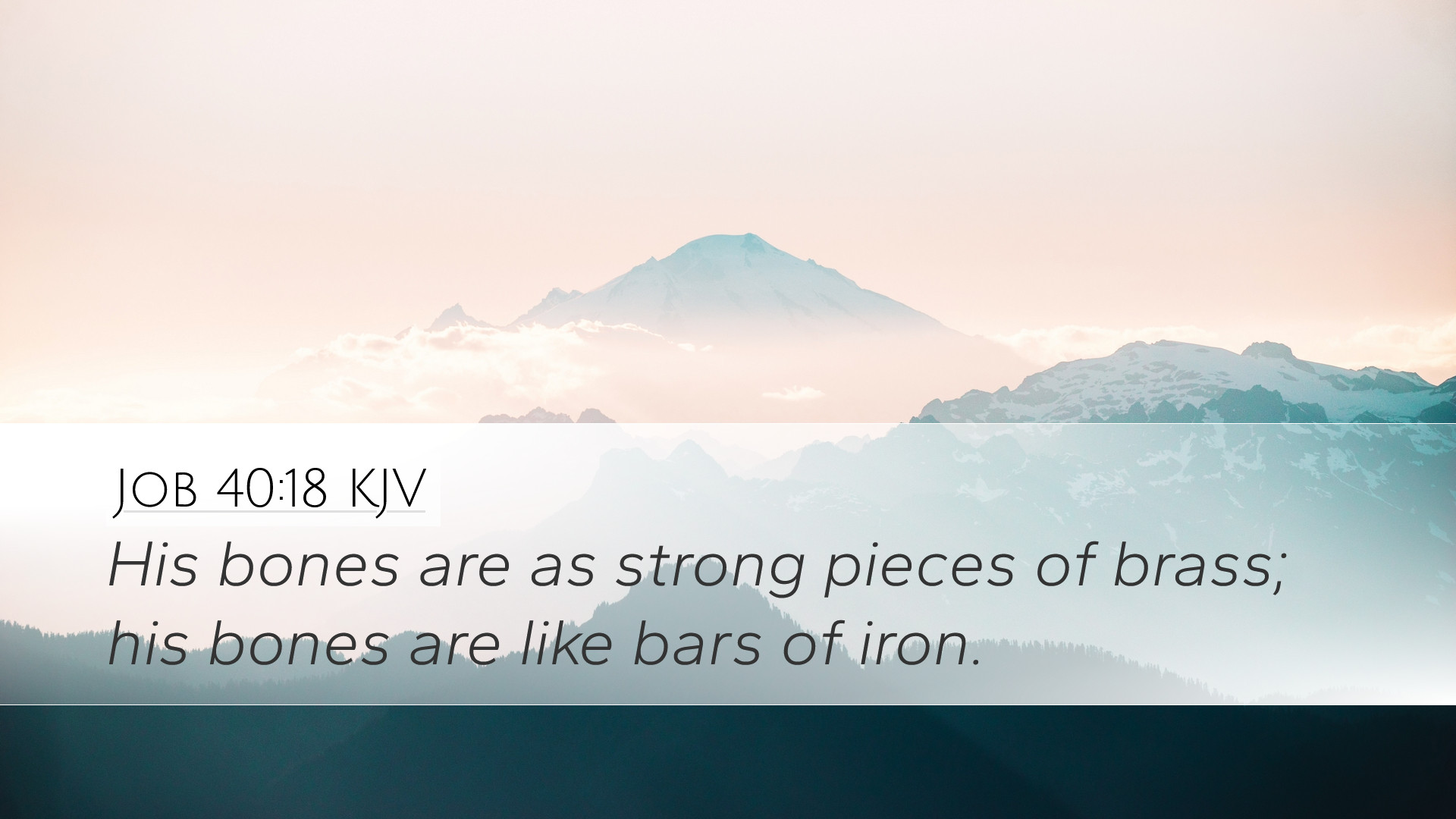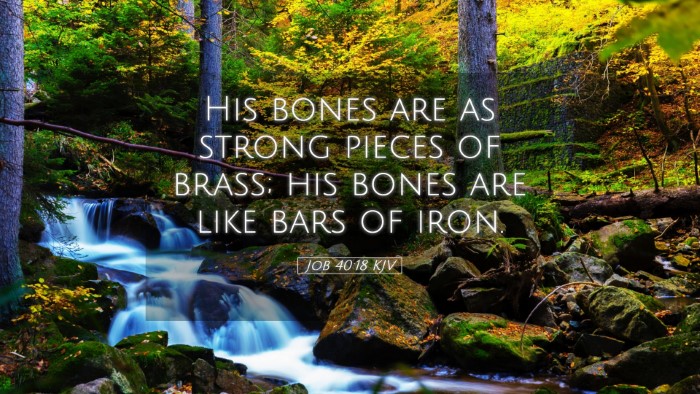Old Testament
Genesis Exodus Leviticus Numbers Deuteronomy Joshua Judges Ruth 1 Samuel 2 Samuel 1 Kings 2 Kings 1 Chronicles 2 Chronicles Ezra Nehemiah Esther Job Psalms Proverbs Ecclesiastes Song of Solomon Isaiah Jeremiah Lamentations Ezekiel Daniel Hosea Joel Amos Obadiah Jonah Micah Nahum Habakkuk Zephaniah Haggai Zechariah MalachiJob 40:18
Job 40:18 KJV
His bones are as strong pieces of brass; his bones are like bars of iron.
Job 40:18 Bible Commentary
Commentary on Job 40:18
Job 40:18 states, "His bones are as strong pieces of brass; his bones are like bars of iron." This verse presents a vivid image of a creature that exemplifies strength and power, and it invites deeper theological and literary reflection. The commentaries from notable theologians provide various insights into its meaning and implications.
Introduction to Job 40:18
This verse comes from a pivotal section of the Book of Job where God responds to Job’s lamentations about his suffering. The depiction of this creature illustrates themes of God's creation, power, and sovereignty. Understanding this verse leads us to consider not just the physical aspects but also the theological significance.
The Creature’s Description
According to Matthew Henry, the creature in question could be a reference to the behemoth, a representation of immense strength and might. He emphasizes how the description aligns with the characteristics of God’s creation:
- Strength and Stability: The bones being compared to brass and iron indicate unyielding strength, underscoring the idea that God’s creations possess inherent power.
- Symbolism of Resilience: This resilience meets the context of Job's suffering, suggesting that while Job feels weak and defeated, God's creations remain powerful and steadfast.
Theological Implications
Albert Barnes touches on the implications of the description of the behemoth not just as a physical being but as a symbol of God’s sovereignty over all of creation:
- Divine Sovereignty: The verse showcases God’s control and authority over creation, reaffirming the belief that God is aware of all, powerful over all, and capable of maintaining order.
- Job’s Perspective: Barnes highlights that through this imagery, God redirects Job’s focus from his suffering to the majesty of creation, inviting him to see the bigger picture of divine providence.
Literary Structure and Imagery
Adam Clarke analyzes the literary aspects of the verse, suggesting that the descriptions serve to engage the reader’s imagination:
- Imagery of Strength: The intentional use of metals like brass and iron elevates the creature's physicality as fearsome and invincible, thereby invoking awe toward God’s craftsmanship.
- Contrast with Humanity: Clarke points out that while humans may find themselves in positions of weakness, the strength described here serves as a reminder of what is far beyond human ability or understanding.
Contextual Analysis
To fully appreciate Job 40:18, it is crucial to consider its broader context within the Book of Job. This section is part of God’s answer to Job, where He highlights His unmatched creative power:
- Role of Suffering: This part of Job serves to remind that suffering is a part of the human experience, but God’s ability to create and govern the universe is not diminished by human struggles.
- Call to Humility: Through the imagery of the behemoth, God calls Job—and by extension, all readers—to humility in recognizing our limitations versus God’s omnipotence.
Reflections for Pastors and Theologians
This verse has much to offer those in pastoral and academic circles:
- Encouragement in Preaching: Pastors can draw on the themes of strength and divine sovereignty, encouraging congregations to understand that God reigns supreme despite appearances to the contrary.
- Scholarly Inquiry: Theologians may explore the creature’s identity and significance, prompting further dialogue on creation, anthropology, and divine interaction with humanity.
Conclusion
Job 40:18 serves as a powerful illustration of God's creative might and serves to remind humanity of their own frailty. Through the combined insights of Matthew Henry, Albert Barnes, and Adam Clarke, we see a holistic understanding of God's nature, the implications of His strength, and the consequent call for humility. In contexts of suffering, we are invited to reflect on God's sovereignty and the profound mysteries of His works.


